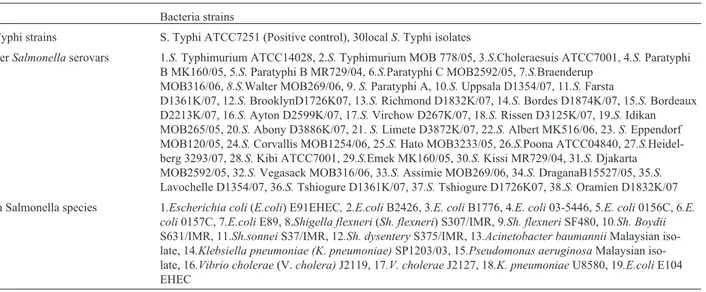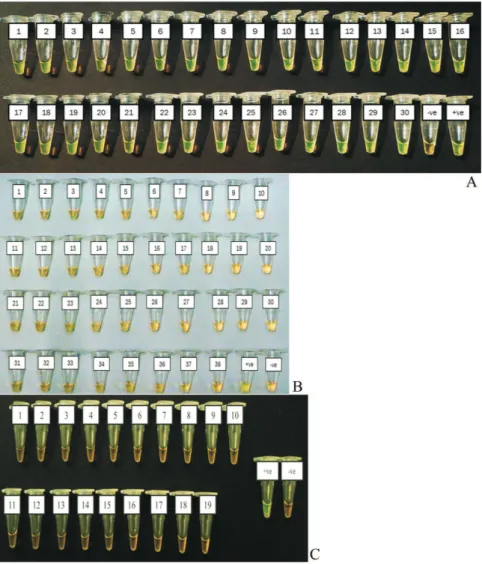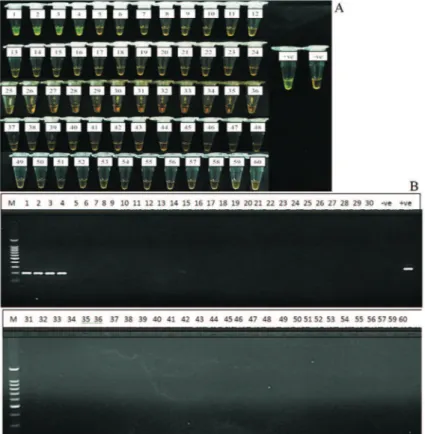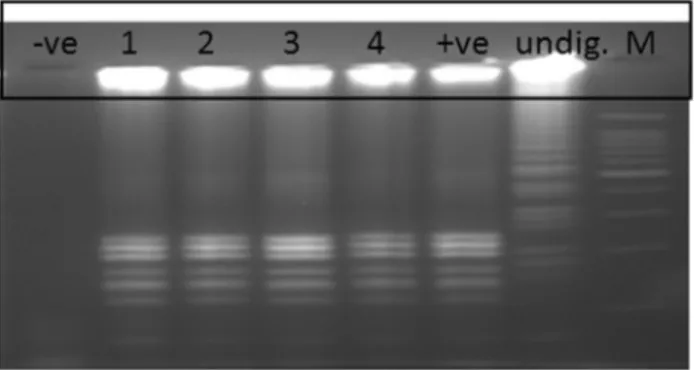Rapid detection of
Salmonella
Typhi by loop-mediated isothermal amplification
(LAMP) method
J. Abdullah
1, N.Saffie
1, F.A.R.Sjasri
1, A.Husin
3, Z.Abdul-Rahman
2, A.Ismail
1,
I. Aziah
1, M. Mohamed
11
Institute for Research in Molecular Medicine, Kubang Kerian, Kelantan. 2
School of Medical Sciences, Universiti Sains Malaysia, Kubang Kerian, Kelantan. 3
Hospital Raja Perempuan Zainab II, 15586 Kota Bharu, Kelantan, Malaysia
Submitted: August 19, 2013; Approved: April 17, 2014.
Abstract
An in-house loop-mediated isothermal amplification (LAMP) reaction was established and evalu-ated for sensitivity and specificity in detecting the presence ofSalmonellaTyphi (S. Typhi) isolates from Kelantan, Malaysia. Three sets of primers consisting of two outer and 4 inner were designed based on locus STBHUCCB_38510 of chaperone PapD ofS.Typhi genes. The reaction was opti-mised using genomic DNA ofS.Typhi ATCC7251 as the template. The products were visualised di-rectly by colour changes of the reaction. Positive results were indicated by green fluorescence and negative by orange colour. The test was further evaluated for specificity, sensitivity and application on field samples. The results were compared with those obtained by gold standard culture method and Polymerase Chain Reaction (PCR). This method was highly specific and -10 times more sensi-tive in detectingS.Typhi compared to the optimised conventional polymerase chain reaction (PCR) method.
Key words:loop-mediated isothermal amplification (LAMP),SalmonellaTyphi.
Introduction
Salmonella enterica subspecies enterica serovar Typhi (S.Typhi) causes typhoid fever, a systemic febrile illness in humans. It is transmitted by the fecal-oral route, mainly via contaminated food and water. This disease re-mains an important cause of global morbidity and mortal-ity, especially in developing countries, with an estimated annual incidence of 21 million cases and more than 700,000 deaths reported worldwide (Wainet al., 2003). In Malay-sia,S.Typhi is endemic with 1-4 cases per 100,000 popula-tions (http://www.dph.gov.my/cdc/Disease List.htm).
A rapid and sensitive method for the detection ofS. Typhi would help both in preventing the spread of out-breaks and in clinical diagnosis. The conventional methods for the detection of Salmonella require multiple subculture steps, followed by biochemical and serological confirma-tion, taking more than 3 days to get the result (ISO, 2003). Molecular methods such as PCR, real-time PCR, and DNA
microarray, have been successfully used to detect a number of food-borne bacterial pathogens (Liet al., 2009; Malorny et al., 2008; Wattiauet al., 2008; Zhuet al., 1996). How-ever these methods require a well-trained staff and sophisti-cated equipment which generally are not available in devel-oping countries or point-of-care testing facilities (Curtiset al., 2008). Therefore, a simple, rapid, sensitive and specific test to diagnoseS.Typhi infections is needed to screen pa-tient samples, especially in developing countries where re-sources are limited.
Loop-mediated isothermal amplification (LAMP) has been reported to amplify DNA with high sensitivity, specificity and rapidity for the detection of pathogens; My-cobacterium avium subsp. Paratuberculosis(Enosawa et al., 2003), Salmonella species (Hara-Kudoet al., 2005), Yersinia pseudotuberculosis (Horisaka et al., 2004), Hu-man immunodeficiency virus type 1(Hosakaet al., 2009), fish nocardiosis (Itanoet al., 2006),Salmonellaspecies (Li et al., 2009),Salmonella entericaisolates (Ohtsukaet al.,
Send correspondence to M. Mohamed. Institute for Research in Molecular Medicine (INFORMM), Kubang Kerian, Kelantan. E-mail: maizan@kk.usm.my, jaemohamed@gmail.com.
2005), dengue virus serotypes (Paridaet al., 2005) and Sal-monellaSerovars (Ueda and Kuwabara, 2009).LAMP re-quires a set of three specially designed primers termed as inner (LF, LB, FIP and BIP) and outer (F3 and B3) that rec-ognize a total of eight distinct sequences on the target DNA. The FIP and BIP primers consist of sequences of sense (F2 and B2) and antisense (F1c and B1c) strands of the target DNA to initiate the LAMP reaction (Notomiet al., 2000). It uses single amplification period and temperature at 60 to 65 °C for 1 h. The product can be visualised directly by tur-bidity due to the accumulation of a by-product of the ampli-fication, magnesium-pyrophosphate. Direct visual identification can be further enhanced by the addition of an intercalating fluorescent dye such as Pico or SYBR Green, where the amplification by-product, pyrophosphate binds and removes the manganese ion from the calcein to irradi-ate the fluorescence. Positive LAMP products also exhibit a ladder-like pattern of bands when observed by gel electro-phoresis (Moriet al., 2001). Thus, in this study, an in-house LAMP method was developed for a rapid, sensitive and specific detection ofS.Typhi using primers that were de-signed based on a published STBHUCCB_38510 locus of S.Typhi gene (Figure 1 and Table 1). Its specificity and sensitivity for the detection ofS.Typhi was assessed and further evaluated on clinical samples suspected ofS.Typhi.
The results were compared with gold standard culture methods and PCR assays.
Materials and Methods
Bacterial strains and DNA extraction
A total of 87 bacteria strains consisting of 30S.Typhi, 38 otherSalmonellaserovars and 19 non-Salmonella species were used in this study. They were obtained from the Insti-tute of Research in Molecular Medicine (INFORMM), Universiti Sains Malaysia’s Culturebank, Kelantan Public Health laboratory and Institute Medical Research (IMR), Malaysia (Table 2). AS.Typhi ATCC7251 strain was used as a positive control and for sensitivity testing of LAMP. The bacteria were identified previously using a procedure based on the EN 1284:1997 method of the European Committee for Standardisation and the Bacteriological Analytical Man-ual Method of the Food and Drug Administration, USA. Genomic DNA was extracted from the enrichment culture broth by boiling method as previously described by Aziahet al., 2007).
Design of LAMP primers
Species-specific primers were designed manually based on a published hypothetical STBHUCCB_38510 gene of P-stx-12 (GenBank accession no. CP_003278), CT
Figure 1- STBHUCCB_38510 gene sequence and location of designed primers (highlighted in bold). Arrows indicate the position and direction of the primers. FIP primer consists of F1c and F2, while BIP consists of B1c and B2.
Table 1- PCR and LAMP primers used in this study.
Primer Sequence of the primer Position of the primer at STBHUCCB_38510 gene
SalTy38510 FIP (F1cF2) 5’ tagaaatagtagagtcagg ttttt gcttttgcaggtattgtgg 3’ 127-145
73-92
SalTy38510 BIP (B1cB2) 5’ ttgccttatctaatacaag ttttt gtaaaaggtggtttgctct 3’ 161-184
215-233
SalTy38510 F3 5’ tctggcactcctgtgcctt 3’ 41-60
SalTy38510 B3 5’ gctcaagacgagaaacagg 3’ 244-262
SalTy38510 LF 5’ atgaaaaatgacgcgagtt 3’ 99-117
18 (GenBank accession no.AL_627280) and Ty2 (GenBank accession no AE_014613) of S. Typhi. Three sets of primers were designed: F3 and B3; FIP (F1cF2) and BIP (B1cB2); and LF and LB (Figure 1 and Table 2). The specificity of the designed primers was confirmed using Blast program on the National Center for Biotechnology server (http:/www.ncbi.nlm.nih.gov).
LAMP assay
LAMP reactions were previously optimized their Betaine and dNTP concentrations, amplification tempera-tures and incubation periods (unpublished data). The opti-mised LAMP reaction was carried out in a 25mL reaction mixture containing 12.5mL of 2x Thermopol buffer (New England Biolabs, UK), 8 mM MgSO4, 0.8 M betaine (Sigma-Aldrich, St. Louis, MO), 2 mM of each deoxynucleoside triphosphate (dNTP)(Promega, USA), 40 pMol of FIP and BIP primers, 5 pMol of F3 and B3 prim-ers, 20 pMol of LF and LB primprim-ers, 8 U ofBstDNA poly-merase, 2mL of DNA template, 0.02mL of Calcein (Merck, Germany); and the mixture was brought to 25mL volume with distilled water. The reaction was incubated at 63 °C for 60 min and terminated by heating at 80 °C for 2 min using heating block. The product was visualised directly with fluo-rescent green indicating a positive reaction and an orange colour indicating a negative reaction. The images of the reac-tion tubes were captured using a camera (Panasonic DMC-FHI). Genomic DNA of Salmonella Typhi ATCC7251 was used as a positive control and in the optimi-sation process.
Specificity of the LAMP assay
To assess the specificity of the assay, LAMP reaction was carried out on the DNA of confirmed positive cultures of 30S.Typhi, 38 otherSalmonellaserovars and 19 non-
Sal-monellaspecies (Table 1).S.Typhi ATCC7251 strain was used as a positive control and the DNA extracted from nega-tive cultures ofS.Typhi was used as a negative control. Each DNA was tested by LAMP at least twice.
Sensitivity of the LAMP assay
The sensitivity of the assay was determined using 10-fold serial dilutions of an overnight culture ofS.Typhi ATCC7251 strain in nutrient broth. To count the bacteria, 100mL aliquot of appropriate dilutions were spread in dupli-cate on nutrient agar plates and colonies on these plates were counted after incubation for 24 h at 37 °C. A 100mL aliquot of each dilution (108cfu/mL to 104cfu/mL) was used to ex-tract the DNA by boiling method (Aziahet al., 2007). Two ml of the extracted DNA was added to the LAMP reaction. The results were compared with the sensitivity result ob-tained by conventional PCR.
PCR was conducted and optimised in a 50mL reaction mixture containing 2.5 mM MgCl2, 0.2 M of each dNTP (Promega, USA), 2.5U of Taq polymerase (Promega, USA), 20rmol of F3 and B3 primers and 2mL of DNA. PCR was performed at 94 °C for 5 min, followed by 35 cycles of 94 °C for 1 min, 50 °C for 1 min, 72 °C for 1 min and a final exten-sion step at 72 °C for 10 min. PCR products were separated by electrophoresis on a 2% agarose gel, stained with ethidium bromide and visualised by UV translumination.
Clinical validation of LAMP for diagnosis
To assess the ability of LAMP method to detect S. Typhi from clinical samples, 60 BACTEC blood culture broths suspected ofS. Typhi were used in this study. These culture broths were obtained from the Diagnostic Laboratory of Microbiology and Parasitology Department, Universiti Sains Malaysia and Diagnostic Laboratory of Microbiology Department, Hospital Raja Perempuan Zainab II (HPRZ II),
Table 2- Bacterial strains used in this study.
Bacteria strains
S.Typhi strains S. Typhi ATCC7251 (Positive control), 30localS. Typhi isolates
OtherSalmonellaserovars 1.S.Typhimurium ATCC14028, 2.S.Typhimurium MOB 778/05, 3.S.Choleraesuis ATCC7001, 4.S.Paratyphi B MK160/05, 5.S.Paratyphi B MR729/04, 6.S.Paratyphi C MOB2592/05, 7.S.Braenderup
MOB316/06,8.S.Walter MOB269/06, 9.S.Paratyphi A, 10.S.Uppsala D1354/07, 11.S.Farsta
D1361K/07, 12.S.BrooklynD1726K07, 13.S.Richmond D1832K/07, 14.S.Bordes D1874K/07, 15.S.Bordeaux D2213K/07, 16.S.Ayton D2599K/07, 17.S.Virchow D267K/07, 18.S.Rissen D3125K/07, 19.S.Idikan MOB265/05, 20.S.Abony D3886K/07, 21.S.Limete D3872K/07, 22.S.Albert MK516/06, 23.S.Eppendorf MOB120/05, 24.S.Corvallis MOB1254/06, 25.S.Hato MOB3233/05, 26.S.Poona ATCC04840, 27.S. Heidel-berg 3293/07, 28.S.Kibi ATCC7001, 29.S.Emek MK160/05, 30.S.Kissi MR729/04, 31.S.Djakarta MOB2592/05, 32.S.Vegasack MOB316/06, 33.S.Assimie MOB269/06, 34.S.DraganaB15527/05, 35.S.
Lavochelle D1354/07, 36.S.Tshiogure D1361K/07, 37.S.Tshiogure D1726K07, 38.S.Oramien D1832K/07
Non Salmonella species 1.Escherichia coli(E.coli) E91EHEC,2.E.coliB2426, 3.E. coliB1776, 4.E. coli03-5446, 5.E. coli0156C, 6.E. coli0157C, 7.E.coliE89, 8.Shigella flexneri(Sh. flexneri) S307/IMR, 9.Sh. flexneriSF480, 10.Sh. Boydii
S631/IMR, 11.Sh.sonneiS37/IMR, 12.Sh. dysenteryS375/IMR, 13.Acinetobacter baumanniiMalaysian iso-late, 14.Klebsiella pneumoniae (K. pneumoniae)SP1203/03, 15.Pseudomonas aeruginosaMalaysian iso-late, 16.Vibrio cholerae(V.cholera)J2119, 17.V. choleraeJ2127, 18.K. pneumoniaeU8580, 19.E.coliE104 EHEC
Kota Bharu, Kelantan Malaysia with the IRB approval. The DNA was also extracted by boiling method(Aziah et al., 2007). The LAMP assay was carried out twice for each sam-ple. To confirm the specificity of DNA band produced by LAMP, 5mL of the products were digested with restriction enzymeHinfI (New England Biolabs) which was analysed to be specific only to S. Typhi amplified sequence region. The reaction was set according to the manufacture’s instruction. The restriction fragments were separated by electrophoresis on a 2% agarose gel, stained with ethidium bromide and visualised by UV translumination. The results were further
confirmed by biochemical culture method. Each DNA of the samples was tested by LAMP at least twice.
Results
Specificity of the LAMP assay using bacterial strains
The LAMP reaction only detected DNA from the thirty isolates ofS.Typhi used in this study but not from the 38 otherSalmonellaserovars and 19 nonSalmonella spe-cies (Figure 2A, 2B and 2C).
Figure 2- Specificity of LAMP assay for the detection ofSalmonellaTyphi genomic DNA by direct visualization. (A) Salmonella Typhi 1-30 isolates. (B) Other Salmonella serovars. 1. Salmonella Typhimurium (S. Typhimurium) ATCC14028, 2.STyphimurium MOB 778/05, 3.S.Choleraesuis ATCC7001, 4.S.Paratyphi B MK160/05, 5.S. Paratyphi B MR729/04, 6.S.Paratyphi C MOB2592/05, 7.S.Braenderup MOB316/06, 8.S.Walter MOB269/06, 9.S.Paratyphi A, 10.S.Uppsala D1354/07, 11.S.Farsta D1361K/07, 12.S.Brooklyn D1726K07, 13.S.Richmond D1832K/07, 14.S.Bordes D1874K/07, 15.S.Bordeaux D2213K/07, 16.S.Ayton D2599K/07, 17.S.Virchow D267K/07, 18.S.Rissen D3125K/07, 19.S.IdikanMOB265/05, 20.S.
Abony D3886K/07, 21.S.Limete D3872K/07, 22.S.Albert MK516/06, 23.S.Eppendorf MOB120/05, 24.S.Corvallis MOB1254/06, 25.S.Hato MOB3233/05, 26.S.Poona ATCC04840, 27.S.Heidelberg 3293/07, 28.S.Kibi ATCC7001, 29.S.Emek MK160/05, 30.S.Kissi MR729/04, 31.S.Djakarta MOB2592/05, 32.S.Vegasack MOB316/06, 33.S. Assimie MOB269/06, 34.S. DraganaB15527/05, 35.S. Lavochelle D1354/07, 36.S.Tshiogure D1361K/07, 37.S.Tshiogure D1726K07, 38.S.Oramien D1832K/07. (C) Non Salmonella species. 1.Escherichia coli(E. coli) E91EHEC,2.E.coli
B2426, 3.E. coliB1776, 4.E. coli03-5446, 5.E. coli0156C, 6.E. coli0157C,7.E.coliE89, 8.Shigella flexneri(Sh. flexneri) S307/IMR, 9.Sh. flexneri
Sensitivity of the LAMP assay
The sensitivity of the LAMP assay used in this study was 20 CFU/reaction while for the optimised PCR assay was 200 CFU (Figure 3A, 3B and 3C). Thus, the sensitivity of the LAMP assay used in this study was 10 times higher than that of the optimised conventional PCR.
Evaluation on clinical samples
Evaluation of the LAMP assay on 60 clinical samples showed 100% agreement with gold standard culture meth-ods and PCR assays, where four tubes (Tubes 1-4) of the confirmed positive cultures ofS.Typhi were also positive by LAMP method while the other 56 negative cultures were also negative by LAMP (Figure 4A). Same results were also obtained by PCR assay (Figure 4B). These positive LAMP products were successfully digested withHinfI en-zyme that was specific only to the amplified STBHUCCB_38510 gene of theS. Typhi (Figure 5).
Discussion
Simple, specific and sensitive diagnostic tests are needed for early detection of pathogens, especially in low resource-settings. Current diagnosis ofS. Typhi is via cul-turing techniques and molecular methods such as PCR and real-time PCR (Levyet al., 2008; Malornyet al., 2008). However, the conventional culture method is
time-consuming and can take more than 3 days to obtain results (Hara-Kudoet al., 2005). Despite the rapidity and sensitiv-ity provided by PCR-based detection methods, they are not widely used in private clinics or health care settings due to
Figure 3- Sensitivity of (3A & 3B) LAMP observed by direct visualisa-tion and agarose gel electrophoresis respectively and (3C) PCR assay. M: DNA marker,Tube/lane 1: 2 x 105cfu,tube/lane 2: 2 x 104cfu, tube/lane 3: 2 x 103cfu, tube/lane 4: 2 x 102cfu,tube/lane 5: 2 x 101cfu, lane 6: 2 x 100 cfu, lane 7:-ve control.
the need of sophisticated equipment and well-trained staff to conduct the testing.
In this study, we have successfully established and optimised an in-house LAMP method based on a hypotheti-cal gene locus STBHUCCB_38510 of S. Typhi strains P-stx-12, CT18 and Ty2. The LAMP reactions were opti-mised at 63 °C for 1 h with 0.8 M betaine, 2.0 mM dNTP and 8 mM MgSO4concentration. This particular-LAMP re-action detected onlyS.Typhi isolates and not the other Sal-monella and non-Salmonella strains tested in this study. The method was also able to differentiate betweenS.Typhi and its closely related bacteria species (e.g., S. Typhimurium andS.Paratyphi A). Therefore this LAMP could be used to detect and differentiateS.Typhi from other Salmonellaand non-Salmonellaspecies.
For the analytical sensitivity, our study showed that this in-house LAMP assay is 10 times more sensitive than PCR assay, which is in agreement with results of a previous study (Etanoet al., 2006). Therefore it could be a better al-ternative method for screening samples with small amount ofS. Typhi that might escape the PCR detection.
Evaluation of this in-house LAMP assay on 60 BACTEC blood culture broths further supported its prom-ising potential to be used in the diagnosis of typhoid fever as the assay correctly identified four samples as positive with no false positive or false negative results (100% speci-ficity and sensitivity) as compared to the biochemical tests and PCR assay. The specificity of the LAMP product was further confirmed by digestion with HinfI restriction en-zyme where the enen-zyme has recognised only theS. Typhi amplified sequence.
Due to the simplicity, specificity and cost advantages offered by this in-house LAMP, it could potentially be used at resource-limited settings especially in the developed and under developed countries. However, this LAMP cannot be used at point-of-care (POC) because it is still requires elec-tricity for BACTEC blood culture incubation, DNA prepa-ration and incubation of the reaction. Therefore, our
on-going research is looking for the DNA extraction method without the need of electricity and innovating the portable heating block that can be operated using battery or solar for incubation of the reaction.
In conclusion, in-house LAMP assay established in this study is a rapid, sensitive and specific method that could potentially be used for the detection ofS.Typhi at low-resource settings. However this LAMP method is only recommended for screening purposes and needs to be fur-ther confirmed with gold standard methods which are cul-ture method and PCR.
Acknowledgments
The authors would like to thank Ms Haslizai Hassan for her technical assistance. This study was supported by the ‘Isothermal amplification’ research project funded by the Ministry of Higher Education (MoHE), Malaysia and USM Research University Cluster Grant 1001/PSKBP/8630017.
Conflict of Interest
All authors declare to have no conflict of interest.
References
Aziah I, Ravichandran M, Asma I (2007). Amplification of ST50 gene using dry-reagent-based polymerase chain reaction for the detection ofSalmonellaTyphi. Diag Microb and Infec Dis 59:373-377.
Communicable Disease Control Section, Communicable Disease Control Section, Disease Control Division, Ministry of Health Malaysia. 2008. Typhoid (Typhoid fever).
Available at http://www.dph.gov.my/cdc/Disease List.htm. Acessed 11 Nov 2009.
Curtis KA, Rudolph DL, Owen SM (2008). Rapid detection of HIV-1 by reverse transcription, loop-mediated isothermal amplification (RT-LAMP). J Virol Methods 151:264-270. Enosawa M, Kageyama S, Sawai K (2003). Use of loop-mediated
isothermal amplification of the IS900 sequence for rapid de-tection of cultured Mycobacterium avium subsp. Paratuberculosis. J Clin Microbiol 41(9):4359-4365. Hara-Kudo Y, Yoshino M, Kojima T (2005). Loop-mediated
iso-thermal amplification for the rapid detection of Salmonella. FEMS Microbiol. Lett 253:155-161.
Horisaka T, Fujita K, Iwata T (2004). Sensitive and specific detec-tion ofYersinia pseudotuberculosisby loop-mediated iso-thermal amplification. J Clin Microbiol 42:5349-5352. Hosaka N, Ndembi N, Ishizaki A (2009). Rapid detection of
hu-man immunodeficiency virus type 1 group M by a reverse transcription-loop-mediated isothermal amplification assay. J Virol Methods 157:195-199.
ISO (6579:2003). Microbiology of food and animal feeding stuffs. Horizontal method for the detection ofSalmonella In-ternational Organization for Standardization, Geneva, Swit-zerland.
Itano T, Kawakami H, Kono T (2006). Detection of fish nocardiosis by loop-mediated isothermal amplification. J Appl Microbiol 100:1381-1387.
Levy H, Diallo S, Tennant SM (2008). PCR method to identify
Salmonella enteric serovars Typhi, Paratyphi A, and Paratyphi B amongSalmonellaisolates from the blood of patients with clinical enteric fever. J Clin Microbiol 46:1861-1866.
Li X, Zhang S, Zhang H (2009). A loop-mediated isothermal am-plification method targets the phoP gene for the detection of
Salmonella in food samples. Int J Food Microbiol 133:252-258.
Malorny B, Lofstrom C, Wagner M (2008). Enumeration of Sal-monella bacteria in food and feed samples by real-time PCR for quantitative microbial risk assessment. Appl Environ Microbiol 74:1299-1304.
Mori Y, Nagamine K, Tomita N (2001). Detection of loop-me-diated isothermal amplification reaction by turbidity derived from magnesium pyrophosphate formation. Biochem Biophys Res Commun 289(1):150-154.
Notomi T, Okayama H, Masubuchi H (2000). Loop-mediated iso-thermal amplification of DNA. Nucleic Acids Res 28 (12): e63.
Ohtsuka K, Yanagawa K, Takatori K, Hara-Kudo Y (2005). De-tection ofSalmonella entericain Naturally Contaminated Liquid Eggs by Loop-Mediated Isothermal Amplification,
and Characterization ofSalmonellaIsolates. Appl Environ Microbiol. 71(11):6730-6735.
Parida M, Horioke K, Ishida H (2005). Rapid detection and differ-entiation of dengue virus serotypes by a real-time reverse transcription-loop-mediated isothermal amplification assay.
J Clin Microbiol 43:2895-2903.
Ueda S and KuwabaraY(2009). The rapid detection ofSalmonella
from food samples by loop-mediated isothermal amplifica-tion (LAMP). Biocontrol Sci 14(2):73-76.
Wain J, Diem Nga LT, Kidgell C (2003). Molecular analysis of incHI1 antimicrobial resistance plasmids from Salmonella serovar Typhi strains associated with typhoid fever. Antimicrob Agents Chemother 47:2732-2739.
Wattiau P, Weijers T, Andreoli P (2008). Evaluation of the Pre-mix Test Salmonella, a commercial low-density DNA microarray system intended for routine identification and typing of Salmonella enterica. Int J Food Microbiol 123:293-298.
Zhu Q, Lim CK, Chan YN (1996). Detection ofSalmonellaTyphi by polymerase chain reaction. J Appl Microbiol 80:244-251.




